Battery Energy Storage Capacity Estimation for Microgrids Using Digital Twin Concept
Abstract
1. Introduction
- Designers can make informed decisions by observing the true dynamics of a system in a virtual environment;
- Maintenance schedules can be effectively planned;
- Modifications and upgrades can be safely verified using DT before integrating them into the actual system;
- System performance can be evaluated without disturbing the real system.
- DT enhances financial decision-making capabilities;
- Operational costs can be significantly reduced by using remote monitoring.
2. Battery Energy Storage Systems in MGs
- To maintain the system stability by compensating for the sudden voltage variations caused by renewable energy sources;
- To increase the revenue by storing energy during low-tariff periods.
3. Microgid Digital Twin (MGDT)
- Capturing the necessary information to assist designers in selecting appropriate battery energy storage systems (BESS) for microgrids during the design and expansion stages;
- Assisting operators in scheduling maintenance for operational microgrids.
3.1. DCMG Case Study
3.1.1. Load Profile of the MG
3.1.2. Battery Model
3.2. Period Parameter Fine Tuning
4. Battery Health Monitoring
Rainflow Cycle Counting
- If the water flow terminates due to the end of the time series;
- If the water flow terminates due to merging with another water flow that initiated in an earlier peak/valley;
- If the water flow terminates due to a higher peak/valley.
5. Design Methodology
6. Results and Discussion
- It can be employed in the planning stage to select the appropriate BESS;
- It can be employed in the operation stage to schedule maintenance based on the BESS operation conditions;
- It can be employed in the decision-making process for future expansions.
7. Conclusions
Author Contributions
Funding
Data Availability Statement
Conflicts of Interest
References
- Fuller, A.; Fan, Z.; Day, C.; Barlow, C. Digital Twin: Enabling Technologies, Challenges and Open Research. IEEE Access 2020, 8, 108952–108971. [Google Scholar] [CrossRef]
- Bazmohammadi, N.; Madary, A.; Vasquez, J.C.; Mohammadi, H.B.; Khan, B.; Wu, Y.; Guerrero, J.M. Microgrid Digital Twins: Concepts, Applications, and Future Trends. IEEE Access 2022, 10, 2284–2302. [Google Scholar] [CrossRef]
- Mike, S.; Mike, C.; Rich, D.; Ed, G.; Chris, K.; Jacqueline, L.; Lui, W. DRAFT Modeling, Simulation, Information Technology & Processing Roadmap Technology Area 11. Natl. Aeronaut. Space Adm. 2012, 32, 1–38. [Google Scholar]
- Pires, F.; Cachada, A.; Barbosa, J.; Moreira, A.P.; Leitão, P. Digital Twin in Industry 4.0: Technologies, Applications and Challenges. In Proceedings of the 2019 IEEE 17th International Conference on Industrial Informatics (INDIN), Helsinki, Finland, 22–25 July 2019; Volume 1, pp. 721–726. [Google Scholar]
- EIA Projects World Energy Consumption Will Increase 56% by 2040. Available online: https://www.eia.gov/todayinenergy/detail.php?id=12251 (accessed on 13 January 2023).
- Microgrid Market. Available online: https://www.transparencymarketresearch.com/microgrid-market.html (accessed on 13 January 2023).
- Boschert, S.; Rosen, R. Digital Twin—The Simulation Aspect. In Mechatronic Futures: Challenges and Solutions for Mechatronic Systems and their Designers; Hehenberger, P., Bradley, D., Eds.; Springer International Publishing: Cham, Switzerland, 2016; pp. 59–74. ISBN 978-3-319-32156-1. [Google Scholar]
- Padmawansa, N.U.; Widanagama Arachchige, L.N. Improving Transient Stability of an Islanded Microgrid Using PV Based Virtual Synchronous Machines. In Proceedings of the 2020 Moratuwa Engineering Research Conference (MERCon), Moratuwa, Sri Lanka, 28–30 July 2020; pp. 543–548. [Google Scholar]
- Global Energy Review: CO2 Emissions in 2021—Analysis. Available online: https://www.iea.org/reports/global-energy-review-co2-emissions-in-2021-2 (accessed on 24 August 2022).
- Padmawansa, N.U.; Abeyratne, S.G.; Rathnayake, D.B.; Lipo, T.A. Enhancement of Inertial Response of an Isolated Microgrid with High Inertia Induction Motors. In Proceedings of the 2019 22nd International Conference on Electrical Machines and Systems (ICEMS), Harbin, China, 11–14 August 2019; pp. 1–5. [Google Scholar]
- Chaudhary, G.; Lamb, J.J.; Burheim, O.S.; Austbø, B. Review of Energy Storage and Energy Management System Control Strategies in Microgrids. Energies 2021, 14, 4929. [Google Scholar] [CrossRef]
- Ibrahim, H.; Ilinca, A.; Perron, J. Energy Storage Systems—Characteristics and Comparisons. Renew. Sustain. Energy Rev. 2008, 12, 1221–1250. [Google Scholar] [CrossRef]
- Chen, H.; Cong, T.N.; Yang, W.; Tan, C.; Li, Y.; Ding, Y. Progress in Electrical Energy Storage System: A Critical Review. Prog. Nat. Sci. 2009, 19, 291–312. [Google Scholar] [CrossRef]
- Palizban, O.; Kauhaniemi, K. Energy Storage Systems in Modern Grids—Matrix of Technologies and Applications. J. Energy Storage 2016, 6, 248–259. [Google Scholar] [CrossRef]
- Marom, R.; Amalraj, S.F.; Leifer, N.; Jacob, D.; Aurbach, D. A Review of Advanced and Practical Lithium Battery Materials. J. Mater. Chem. 2011, 21, 9938–9954. [Google Scholar] [CrossRef]
- Lifetime Expectancy of Lithium-Ion Batteries. Available online: https://www.springerprofessional.de/en/lifetime-expectancy-of-lithium-ion-batteries/18074708 (accessed on 27 July 2022).
- Graditi, G.; Ippolito, M.G.; Telaretti, E.; Zizzo, G. Technical and Economical Assessment of Distributed Electrochemical Storages for Load Shifting Applications: An Italian Case Study. Renew. Sustain. Energy Rev. 2016, 57, 515–523. [Google Scholar] [CrossRef]
- Chen, Y.; Kang, Y.; Zhao, Y.; Wang, L.; Liu, J.; Li, Y.; Liang, Z.; He, X.; Li, X.; Tavajohi, N.; et al. A Review of Lithium-Ion Battery Safety Concerns: The Issues, Strategies, and Testing Standards. J. Energy Chem. 2021, 59, 83–99. [Google Scholar] [CrossRef]
- Spitthoff, L.; Shearing, P.R.; Burheim, O.S. Temperature, Ageing and Thermal Management of Lithium-Ion Batteries. Energies 2021, 14, 1248. [Google Scholar] [CrossRef]
- International Electrotechnical Commission. Electrical Energy Storage: White Paper; International Electrotechnical Commission: Geneva, Switzerland, 2011; ISBN 978-2-88912-889-1. [Google Scholar]
- Faisal, M.; Hannan, M.A.; Ker, P.J.; Hussain, A.; Mansor, M.B.; Blaabjerg, F. Review of Energy Storage System Technologies in Microgrid Applications: Issues and Challenges. IEEE Access 2018, 6, 35143–35164. [Google Scholar] [CrossRef]
- Kawakami, N.; Iijima, Y.; Fukuhara, M.; Bando, M.; Sakanaka, Y.; Ogawa, K.; Matsuda, T. Development and Field Experiences of Stabilization System Using 34MW NAS Batteries for a 51MW Wind Farm. In Proceedings of the 2010 IEEE International Symposium on Industrial Electronics, Bari, Italy, 4–7 July 2010; pp. 2371–2376. [Google Scholar]
- Díaz-González, F.; Sumper, A.; Gomis-Bellmunt, O.; Villafáfila-Robles, R. A Review of Energy Storage Technologies for Wind Power Applications. Renew. Sustain. Energy Rev. 2012, 16, 2154–2171. [Google Scholar] [CrossRef]
- Baker, J. New Technology and Possible Advances in Energy Storage. Energy Policy 2008, 36, 4368–4373. [Google Scholar] [CrossRef]
- Noack, J.; Roznyatovskaya, N.; Herr, T.; Fischer, P. The Chemistry of Redox-Flow Batteries. Angew. Chem. Int. Ed. 2015, 54, 9776–9809. [Google Scholar] [CrossRef] [PubMed]
- Vazquez, S.; Lukic, S.M.; Galvan, E.; Franquelo, L.G.; Carrasco, J.M. Energy Storage Systems for Transport and Grid Applications. IEEE Trans. Ind. Electron. 2010, 57, 3881–3895. [Google Scholar] [CrossRef]
- Korjani, S.; Mureddu, M.; Facchini, A.; Damiano, A. Aging Cost Optimization for Planning and Management of Energy Storage Systems. Energies 2017, 10, 1916. [Google Scholar] [CrossRef]
- Suslov, K.; Shushpanov, I.; Buryanina, N.; Ilyushin, P. Flexible Power Distribution Networks: New Opportunities and Applications. In Proceedings of the 9th International Conference on Smart Cities and Green ICT Systems, Online, 16 January 2023; pp. 57–64. [Google Scholar]
- Shamarova, N.; Suslov, K.; Ilyushin, P.; Shushpanov, I. Review of Battery Energy Storage Systems Modeling in Microgrids with Renewables Considering Battery Degradation. Energies 2022, 15, 6967. [Google Scholar] [CrossRef]
- Xu, B.; Oudalov, A.; Ulbig, A.; Andersson, G.; Kirschen, D.S. Modeling of Lithium-Ion Battery Degradation for Cell Life Assessment. IEEE Trans. Smart Grid 2018, 9, 1131–1140. [Google Scholar] [CrossRef]
- Vetter, J.; Novák, P.; Wagner, M.R.; Veit, C.; Möller, K.-C.; Besenhard, J.O.; Winter, M.; Wohlfahrt-Mehrens, M.; Vogler, C.; Hammouche, A. Ageing Mechanisms in Lithium-Ion Batteries. J. Power Sources 2005, 147, 269–281. [Google Scholar] [CrossRef]
- Meng, J.; Luo, G.; Ricco, M.; Swierczynski, M.; Stroe, D.-I.; Teodorescu, R. Overview of Lithium-Ion Battery Modeling Methods for State-of-Charge Estimation in Electrical Vehicles. Appl. Sci. 2018, 8, 659. [Google Scholar] [CrossRef]
- Erdinc, O.; Vural, B.; Uzunoglu, M. A Dynamic Lithium-Ion Battery Model Considering the Effects of Temperature and Capacity Fading. In Proceedings of the 2009 International Conference on Clean Electrical Power, Capri, Italy, 9–11 June 2009; pp. 383–386. [Google Scholar]
- PIPRO TP660P & TP660P(H)|World-Leading Solar Module Manufacturer|Talesun Solar. Available online: https://www.pvo-int.com/wp-content/uploads/2019/01/TP660P-EN.pdf (accessed on 23 January 2023).
- Gholami, H. Dataset for the Solar Incident Radiation and Electricity Production BIPV/BAPV System on the Northern/Southern Façade in Dense Urban Areas 2021. Available online: https://zenodo.org/record/4804993 (accessed on 7 February 2023).
- Angizeh, F.; Ghofrani, A.; Jafari, M.A. Dataset on Hourly Load Profiles for a Set of 24 Facilities from Industrial, Commercial, and Residential End-Use Sectors. Mendeley Data 2020, 1. [Google Scholar] [CrossRef]
- Qu, X.; Song, Y.; Liu, D.; Cui, X.; Peng, Y. Lithium-Ion Battery Performance Degradation Evaluation in Dynamic Operating Conditions Based on a Digital Twin Model. Microelectron. Reliab. 2020, 114, 113857. [Google Scholar] [CrossRef]
- Baumann, M.; Rohr, S.; Lienkamp, M. Cloud-Connected Battery Management for Decision Making on Second-Life of Electric Vehicle Batteries. In Proceedings of the 2018 Thirteenth International Conference on Ecological Vehicles and Renewable Energies (EVER), Monte Carlo, Monaco, 10–12 April 2018; pp. 1–6. [Google Scholar]
- Li, W.; Rentemeister, M.; Badeda, J.; Jöst, D.; Schulte, D.; Sauer, D.U. Digital Twin for Battery Systems: Cloud Battery Management System with Online State-of-Charge and State-of-Health Estimation. J. Energy Storage 2020, 30, 101557. [Google Scholar] [CrossRef]
- Ma, J.; Xu, S.; Shang, P.; Ding, Y.; Qin, W.; Cheng, Y.; Lu, C.; Su, Y.; Chong, J.; Jin, H.; et al. Cycle Life Test Optimization for Different Li-Ion Power Battery Formulations Using a Hybrid Remaining-Useful-Life Prediction Method. Appl. Energy 2020, 262, 114490. [Google Scholar] [CrossRef]
- Sancarlos, A.; Cameron, M.; Abel, A.; Cueto, E.; Duval, J.-L.; Chinesta, F. From ROM of Electrochemistry to AI-Based Battery Digital and Hybrid Twin. Arch Comput. Methods Eng. 2021, 28, 979–1015. [Google Scholar] [CrossRef]
- Chun, H.; Kim, J.; Yu, J.; Han, S. Real-Time Parameter Estimation of an Electrochemical Lithium-Ion Battery Model Using a Long Short-Term Memory Network. IEEE Access 2020, 8, 81789–81799. [Google Scholar] [CrossRef]
- Jossen, A. Fundamentals of Battery Dynamics. J. Power Sources 2006, 154, 530–538. [Google Scholar] [CrossRef]
- Wenzl, H.; Baring-Gould, I.; Kaiser, R.; Liaw, B.Y.; Lundsager, P.; Manwell, J.; Ruddell, A.; Svoboda, V. Life Prediction of Batteries for Selecting the Technically Most Suitable and Cost Effective Battery. J. Power Sources 2005, 144, 373–384. [Google Scholar] [CrossRef]
- Tankari, M.A.; Camara, M.B.; Dakyo, B.; Lefebvre, G. Use of Ultracapacitors and Batteries for Efficient Energy Management in Wind–Diesel Hybrid System. IEEE Trans. Sustain. Energy 2013, 4, 414–424. [Google Scholar] [CrossRef]
- Simulink—Simulation and Model-Based Design. Available online: https://au.mathworks.com/products/simulink.html (accessed on 17 February 2023).
- Cheng, T.; Lu, D.D.-C.; Siwakoti, Y.P. Circuit-Based Rainflow Counting Algorithm in Application of Power Device Lifetime Estimation. Energies 2022, 15, 5159. [Google Scholar] [CrossRef]
- Rychlik, I. A New Definition of the Rainflow Cycle Counting Method. Int. J. Fatigue 1987, 9, 119–121. [Google Scholar] [CrossRef]
- Downing, S.D.; Socie, D.F. Simple Rainflow Counting Algorithms. Int. J. Fatigue 1982, 4, 31–40. [Google Scholar] [CrossRef]
- Muenzel, V.; de Hoog, J.; Brazil, M.; Vishwanath, A.; Kalyanaraman, S.A. Multi-Factor Battery Cycle Life Prediction Methodology for Optimal Battery Management. In Proceedings of the 2015 ACM Sixth International Conference on Future Energy Systems, Bangalore, India, 14–17 July 2015; Available online: https://dl.acm.org/doi/10.1145/2768510.2768532 (accessed on 25 January 2023).
- Musallam, M.; Johnson, C.M. An Efficient Implementation of the Rainflow Counting Algorithm for Life Consumption Estimation. IEEE Trans. Reliab. 2012, 61, 978–986. [Google Scholar] [CrossRef]
- Loew, S.; Anand, A.; Szabo, A. Economic Model Predictive Control of Li-Ion Battery Cyclic Aging via Online Rainflow-Analysis. Energy Storage 2021, 3, e228. [Google Scholar] [CrossRef]
- Huang, J.; Wang, S.; Xu, W.; Shi, W.; Fernandez, C. A Novel Autoregressive Rainflow—Integrated Moving Average Modeling Method for the Accurate State of Health Prediction of Lithium-Ion Batteries. Processes 2021, 9, 795. [Google Scholar] [CrossRef]
- Shi, Y.; Xu, B.; Tan, Y.; Zhang, B. A Convex Cycle-Based Degradation Model for Battery Energy Storage Planning and Operation. In Proceedings of the 2018 Annual American Control Conference (ACC), Milwaukee, WI, USA, 27–29 June 2018; pp. 4590–4596. [Google Scholar]
- Larsen, C.E.; Irvine, T. A Review of Spectral Methods for Variable Amplitude Fatigue Prediction and New Results. Procedia Eng. 2015, 101, 243–250. [Google Scholar] [CrossRef]
- State of Health Estimation of Cycle Aged Large Format Lithium-Ion Cells Based on Partial Charging. J. Energy Storage 2022, 46, 103855. [CrossRef]
- Wang, J.; Liu, P.; Hicks-Garner, J.; Sherman, E.; Soukiazian, S.; Verbrugge, M.; Tataria, H.; Musser, J.; Finamore, P. Cycle-Life Model for Graphite-LiFePO4 Cells. J. Power Sources 2011, 196, 3942–3948. [Google Scholar] [CrossRef]
- Lithium Iron Phosphate Based Battery—Assessment of the Aging Parameters and Development of Cycle Life Model. Appl. Energy 2014, 113, 1575–1585. [CrossRef]
- Naumann, M.; Spingler, F.B.; Jossen, A. Analysis and Modeling of Cycle Aging of a Commercial LiFePO4/Graphite Cell. J. Power Sources 2020, 451, 227666. [Google Scholar] [CrossRef]
- Lam, L.; Bauer, P. Practical Capacity Fading Model for Li-Ion Battery Cells in Electric Vehicles. IEEE Trans. Power Electron. 2013, 28, 5910–5918. [Google Scholar] [CrossRef]

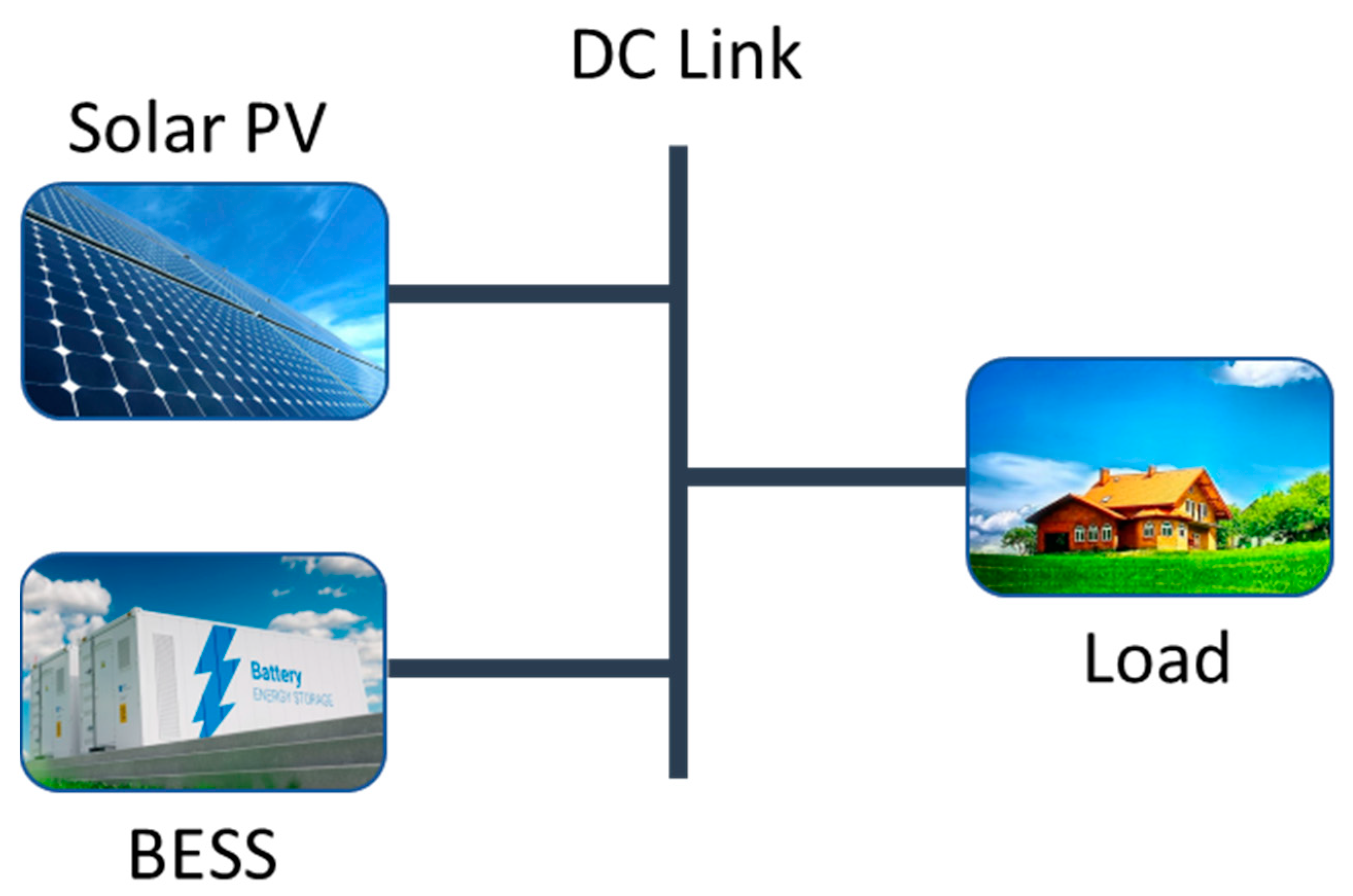
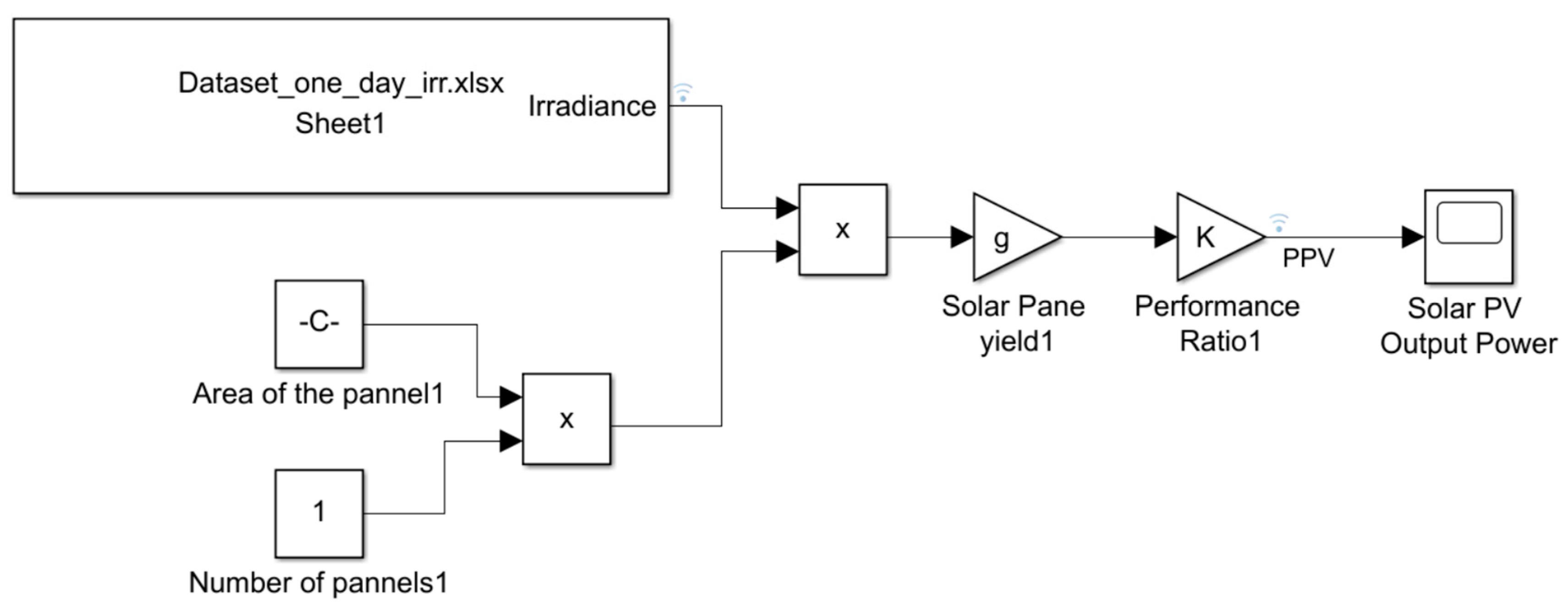

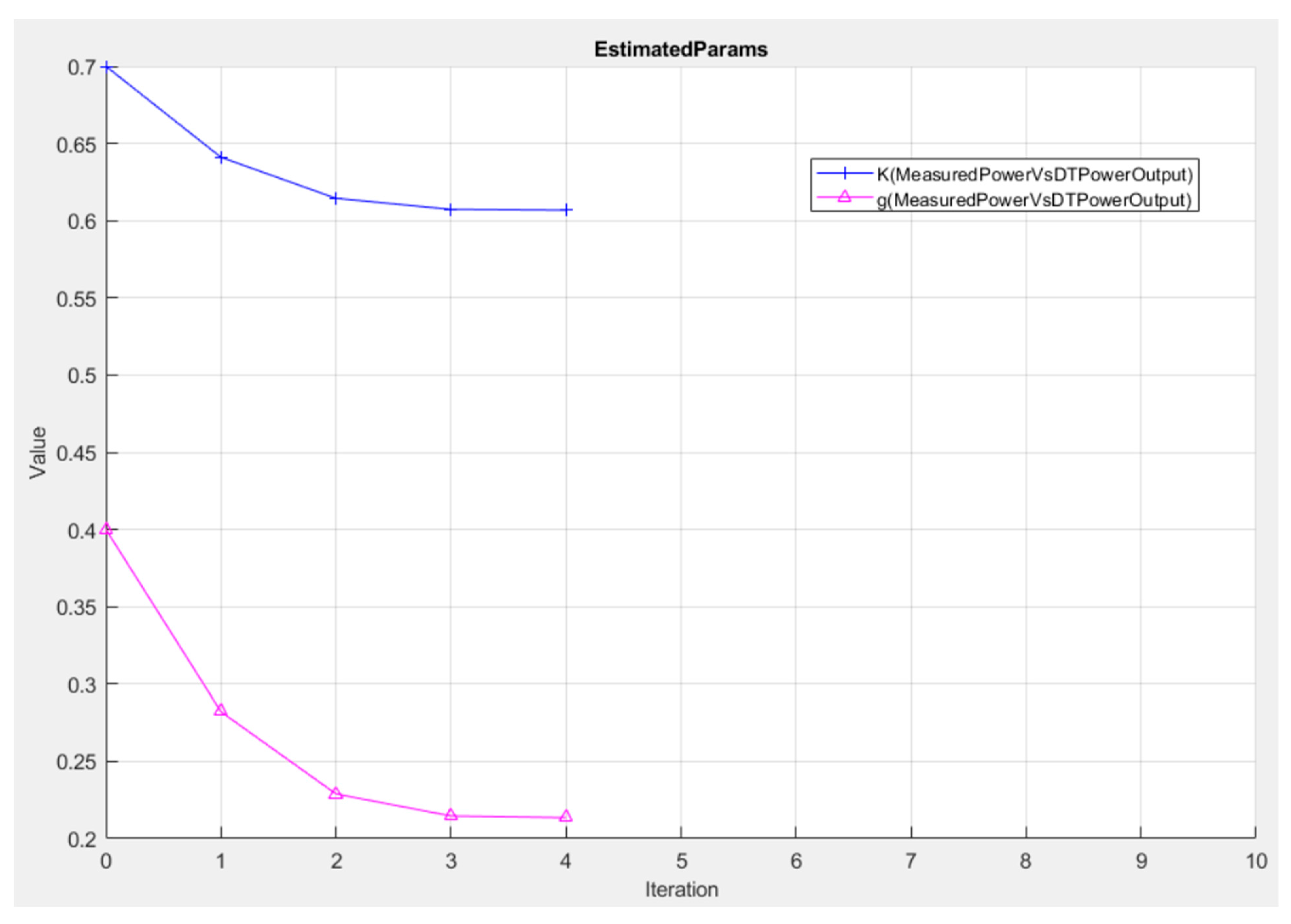

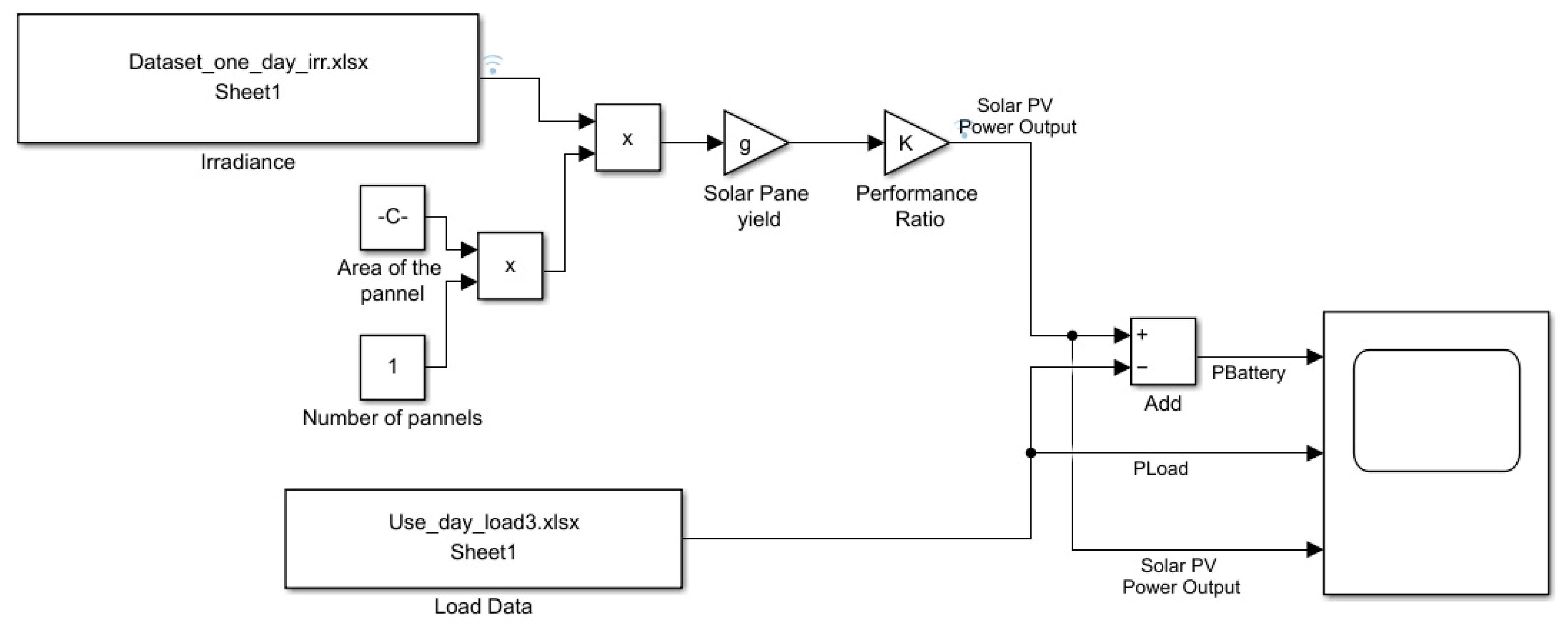
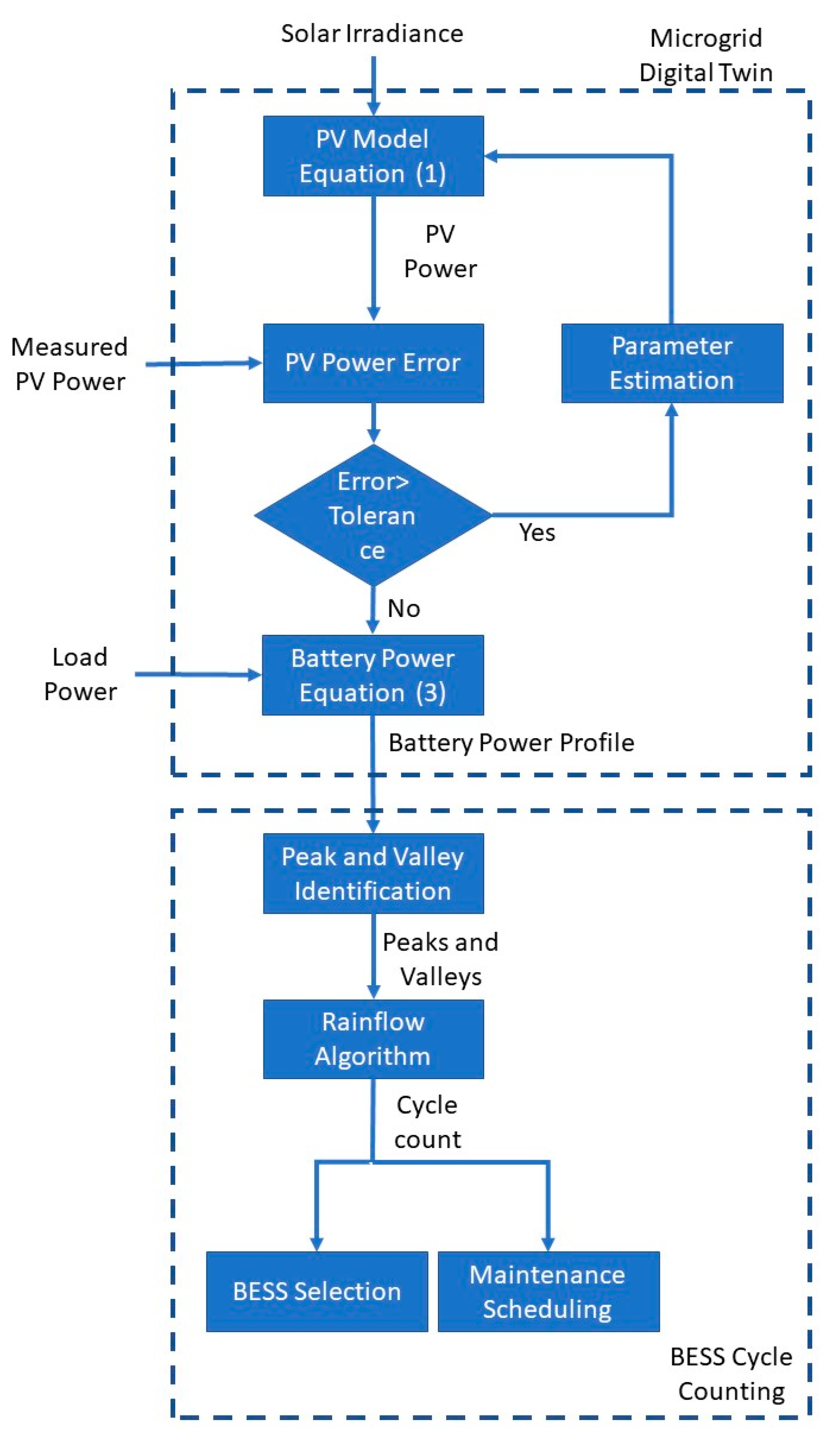
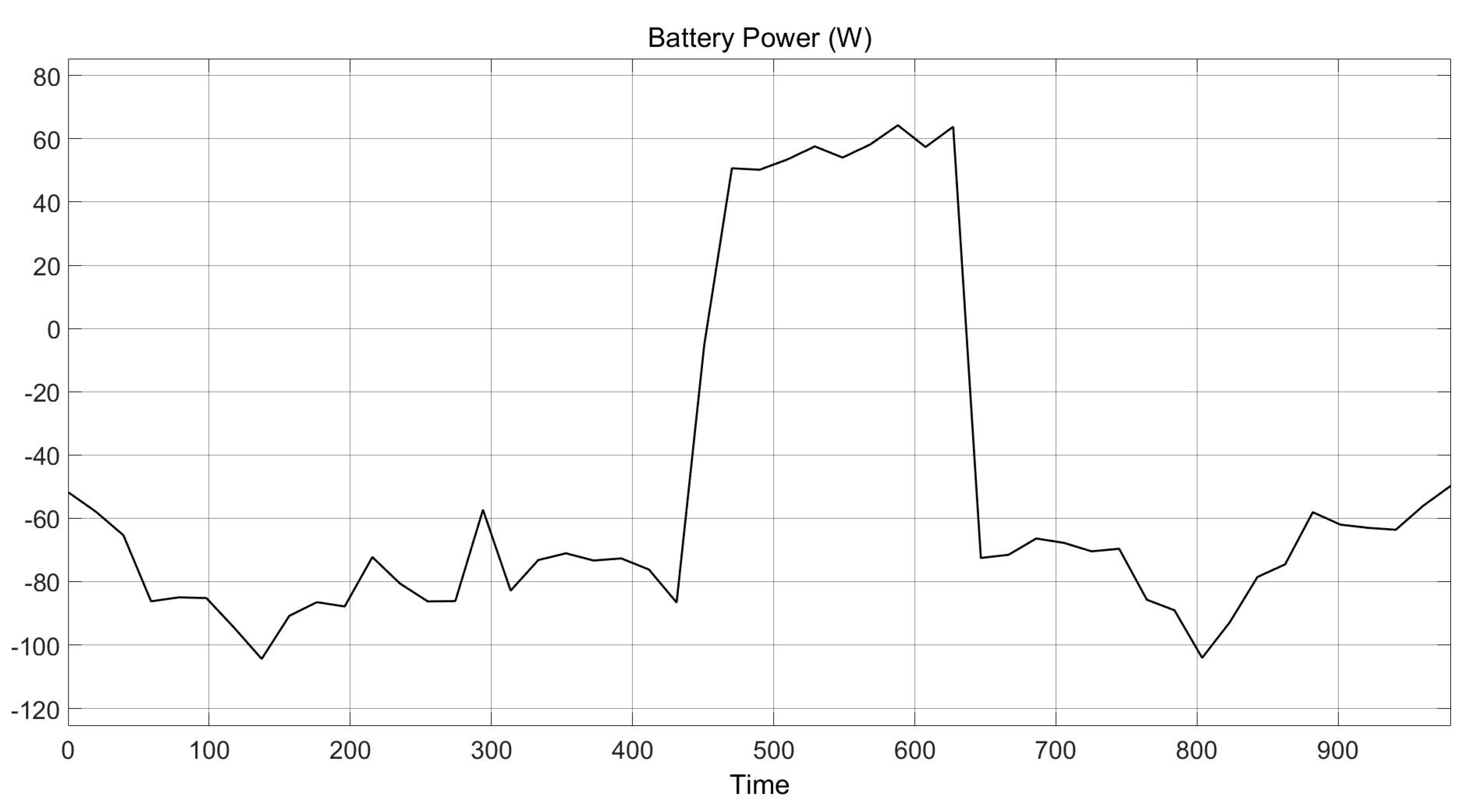
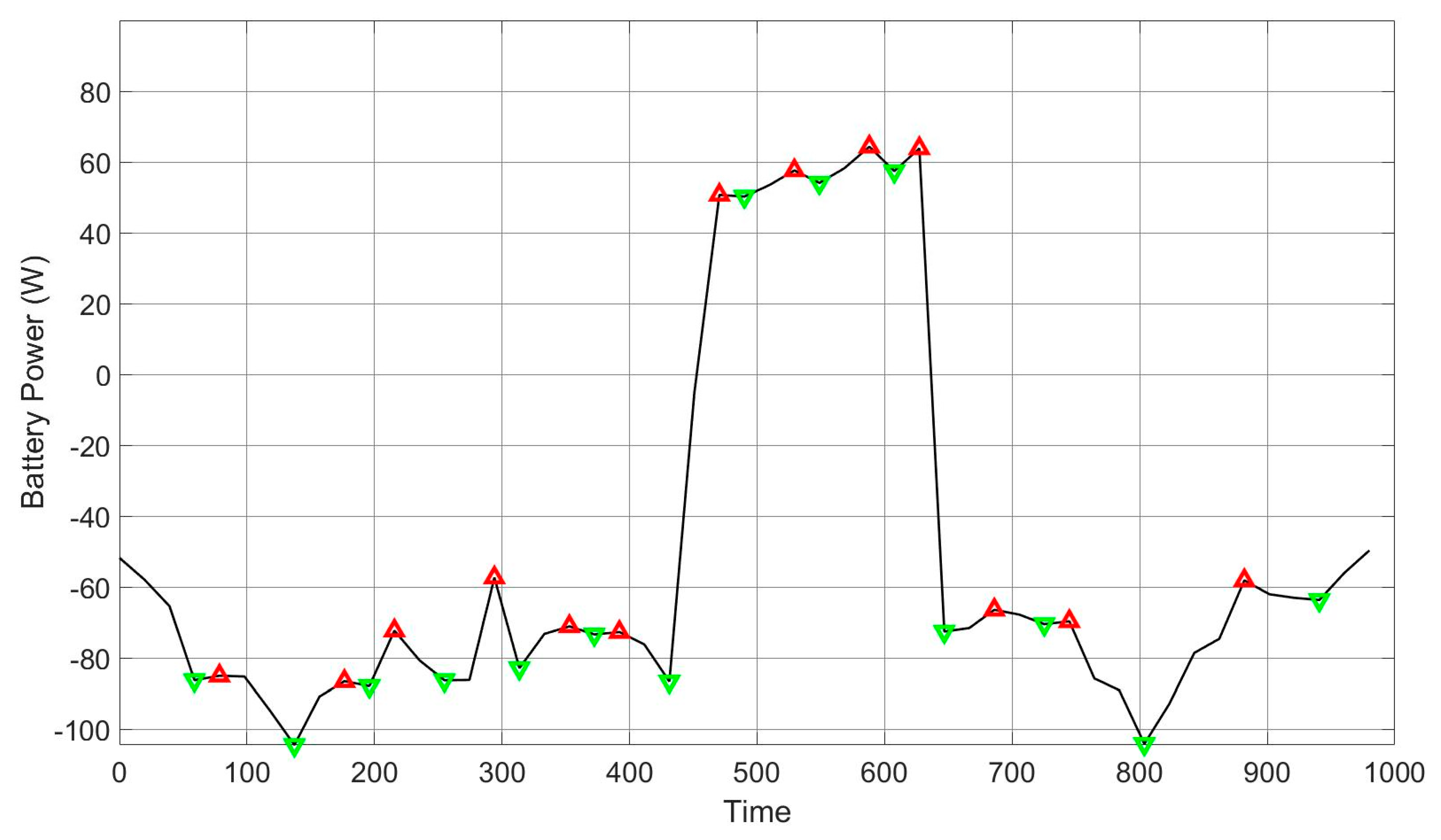

| Feature | Predictive Maintenance | Preventive Maintenance |
|---|---|---|
| Purpose |
|
|
| Frequency |
|
|
| Cost |
|
|
| Complexity |
|
|
| Type | Advantages | Disadvantages | Reference |
|---|---|---|---|
| Lead-Acid Battery |
|
| [11,12,13,14] |
| Lithium-Ion (Li-ion) Battery |
|
| [14,15,16,17,18,19] |
| Sodium-Sulfur (NaS) Battery Storage Systems |
|
| [20,21,22,23,24] |
| Redox Flow Battery |
|
| [11,25,26] |
| Detail | Parameter | Units |
|---|---|---|
| Model | TP660P | |
| Maximum Power output | 275 | W |
| Cell type | Poly Crystalline | |
| Cell Dimensions | 156 × 156 | mm |
| Number of cells | 60 | |
| Operating Voltage | 31.7 | V |
| Open-Circuit Voltage | 38.7 | V |
| Operating Current | 8.69 | A |
| Short-Circuit Current | 9.17 | A |
| Module efficiency | 16.9 | % |
Disclaimer/Publisher’s Note: The statements, opinions and data contained in all publications are solely those of the individual author(s) and contributor(s) and not of MDPI and/or the editor(s). MDPI and/or the editor(s) disclaim responsibility for any injury to people or property resulting from any ideas, methods, instructions or products referred to in the content. |
© 2023 by the authors. Licensee MDPI, Basel, Switzerland. This article is an open access article distributed under the terms and conditions of the Creative Commons Attribution (CC BY) license (https://creativecommons.org/licenses/by/4.0/).
Share and Cite
Padmawansa, N.; Gunawardane, K.; Madanian, S.; Than Oo, A.M. Battery Energy Storage Capacity Estimation for Microgrids Using Digital Twin Concept. Energies 2023, 16, 4540. https://doi.org/10.3390/en16124540
Padmawansa N, Gunawardane K, Madanian S, Than Oo AM. Battery Energy Storage Capacity Estimation for Microgrids Using Digital Twin Concept. Energies. 2023; 16(12):4540. https://doi.org/10.3390/en16124540
Chicago/Turabian StylePadmawansa, Nisitha, Kosala Gunawardane, Samaneh Madanian, and Amanullah Maung Than Oo. 2023. "Battery Energy Storage Capacity Estimation for Microgrids Using Digital Twin Concept" Energies 16, no. 12: 4540. https://doi.org/10.3390/en16124540
APA StylePadmawansa, N., Gunawardane, K., Madanian, S., & Than Oo, A. M. (2023). Battery Energy Storage Capacity Estimation for Microgrids Using Digital Twin Concept. Energies, 16(12), 4540. https://doi.org/10.3390/en16124540









